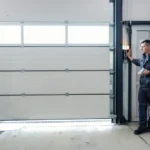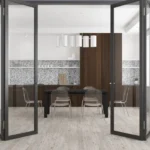Energy-Efficient Warehouse Doors: Cut Costs, Not Corners
In modern industrial operations, energy efficiency isn’t just a trend—it’s a necessity. With rising electricity costs, stricter sustainability goals, and demanding operating environments, every element of a warehouse must work smarter, not harder. Among the most overlooked yet critical components of energy management are the warehouse doors.
Proper Warehouse Doors Installation can make the difference between high operational costs and long-term efficiency. Well-designed, energy-efficient warehouse doors not only regulate temperature and reduce energy loss but also improve workflow and safety.
Let’s explore how the right installation and technology can help you cut costs without cutting corners—turning your warehouse into a high-performance, energy-saving powerhouse.
1. The Hidden Role of Warehouse Doors in Energy Loss
Every time a warehouse door opens, it creates an opportunity for conditioned air to escape and outside air to enter. In climates like the UAE—where warehouses often operate under extreme heat—this constant temperature exchange leads to skyrocketing energy bills.
Poorly sealed or outdated doors allow air leakage, forcing HVAC systems and cooling units to work overtime. Over the course of a year, this energy waste adds up significantly.
A professionally executed Warehouse Doors Installation eliminates these inefficiencies by:
- Using insulated panels to reduce temperature transfer.
- Incorporating tight sealing systems to prevent air leakage.
- Enabling automated operations to limit unnecessary open times.
In short, every second a door remains open matters—especially when energy consumption is a major operational cost.
2. The Rise of Energy-Efficient Door Design
Modern Warehouse Doors Installation focuses not only on functionality but also on sustainability. Manufacturers are now producing advanced doors designed with thermal insulation, airtight seals, and smart automation that minimize power waste.
Key Features of Energy-Efficient Warehouse Doors:
- Polyurethane or polystyrene insulation for maximum thermal resistance.
- Double-skin steel panels for enhanced durability and temperature control.
- Weatherproof seals to prevent dust and humidity infiltration.
- High-speed open/close mechanisms to reduce energy exchange.
These innovations make warehouses greener and operations leaner.
3. Why Energy Efficiency Matters in the UAE
Warehouses in regions like Abu Dhabi and Dubai face unique environmental challenges—intense heat, sand, and humidity. Without proper insulation, cooling systems in industrial facilities consume massive amounts of energy just to maintain moderate temperatures.
Upgrading through an energy-conscious Warehouse Doors Installation can drastically lower operational costs while also contributing to sustainability initiatives.
Benefits for UAE Warehouses Include:
- Lower electricity bills throughout the year.
- Improved worker comfort in temperature-controlled environments.
- Protection for heat-sensitive inventory like electronics or chemicals.
- Enhanced compliance with green building standards such as Estidama and LEED.
Energy efficiency isn’t just an environmental concern—it’s a strategic business move in high-cost energy markets.
4. How Proper Installation Makes the Difference
Even the most advanced doors won’t perform effectively if they’re not installed correctly. Precision alignment, proper sealing, and professional calibration are essential to achieving the intended energy savings.
Professional Installation Ensures:
- Tight-fitting seals that prevent air leaks.
- Balanced alignment for smooth, airtight closure.
- Correct motor calibration for optimized door movement.
- Long-term durability with minimal maintenance.
A professional Warehouse Doors Installation ensures that every component works as designed, maximizing both performance and energy efficiency.
5. Insulated Door Types to Consider
Different warehouse operations require different types of doors, but energy efficiency can be built into nearly every model when chosen wisely.
Popular Energy-Efficient Door Options:
1. Sectional Overhead Doors
- Feature insulated steel panels.
- Ideal for temperature-controlled spaces.
- Offer quiet operation and smooth motion.
2. High-Speed Roll-Up Doors
- Reduce open time by operating at up to 2.5 meters per second.
- Great for high-traffic areas and loading docks.
- Minimize conditioned air loss.
3. Insulated Sliding or Folding Doors
- Provide heavy-duty thermal protection.
- Suitable for large warehouse openings.
Each of these can be optimized through precise Warehouse Doors Installation, customized for your facility’s dimensions and workflow.
6. Smart Automation: Energy Savings Through Intelligence
The integration of automation and smart control systems has revolutionized industrial access management. Smart doors open and close automatically using motion sensors, timers, or RFID access systems—preventing doors from being left open unnecessarily.
Smart Features That Boost Efficiency:
- Automatic closing mechanisms after vehicles pass.
- Temperature sensors that adjust door operation based on climate.
- Remote control and monitoring via mobile apps or building management systems (BMS).
- Usage analytics to optimize energy and maintenance schedules.
By incorporating automation during Warehouse Doors Installation, you ensure that every door movement is intentional and energy-conscious.
7. Long-Term Financial Advantages
While energy-efficient doors may have a slightly higher initial cost, the return on investment (ROI) is substantial.
Financial Benefits Include:
- Up to 30% energy savings per year.
- Reduced wear on HVAC and cooling equipment.
- Extended door lifespan with fewer repairs.
- Lower operational downtime due to smart performance.
Within just a few years, the savings from reduced energy usage often exceed the cost of installation.
8. Maintenance: Keeping Efficiency Intact
Even energy-efficient doors need regular maintenance to perform at their best. Dust buildup, worn seals, or damaged insulation can all reduce efficiency over time.
Top-tier service providers schedule preventive maintenance checks after Warehouse Doors Installation, ensuring that insulation integrity and automation systems remain optimal.
Maintenance Checklist:
- Inspect weather seals and gaskets regularly.
- Lubricate hinges and rollers to prevent friction loss.
- Calibrate sensors and motors for accurate response times.
- Replace worn insulation panels as needed.
A simple maintenance routine helps preserve both energy performance and operational reliability.
9. Sustainability and Environmental Compliance
Energy-efficient Warehouse Doors Installation supports global sustainability initiatives. In eco-conscious regions like the UAE, industries are encouraged to reduce their carbon footprint by improving building envelopes and optimizing energy use.
Installing insulated, automated, and sealed doors contributes to:
- Lower CO₂ emissions.
- Improved energy ratings for facilities.
- Enhanced corporate social responsibility (CSR) compliance.
By choosing greener solutions, businesses not only save money but also strengthen their brand reputation as sustainability leaders.
10. The Future of Energy-Efficient Warehouse Design
As technology evolves, warehouse doors are becoming even more intelligent. Future innovations in Warehouse Doors Installation will likely include:
- AI-driven energy management systems that analyze performance data in real-time.
- Self-adjusting insulation panels based on external temperature changes.
- Solar-integrated door systems for energy self-sufficiency.
- Automated fault detection to prevent performance loss.
These innovations promise to take energy efficiency to new levels, making warehouses smarter, cleaner, and more cost-effective.
Conclusion
In the world of modern logistics and industrial operations, efficiency is everything. Energy-efficient Warehouse Doors Installation is not just about keeping the heat out or the cool air in—it’s about optimizing every movement, every opening, and every watt of power.
By combining smart automation, professional installation, and durable insulated materials, businesses can create warehouse environments that are both sustainable and profitable.
Because in today’s competitive market, cutting costs shouldn’t mean cutting corners — it means investing smarter.




